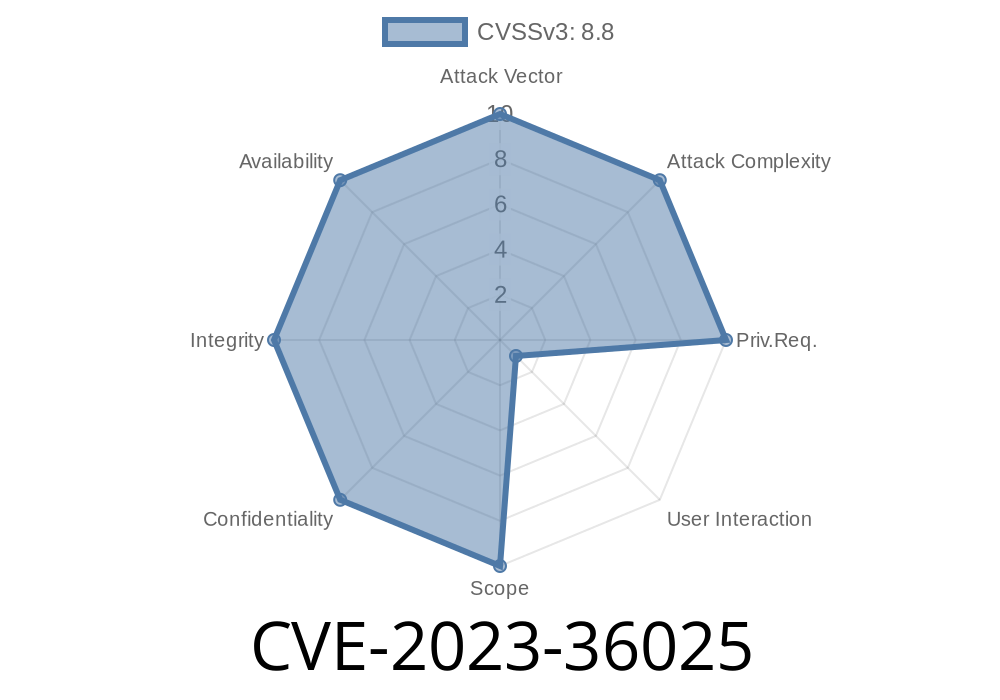Windows SmartScreen is a security feature built into the Windows operating system aimed at protecting users from potentially harmful applications and websites. In this post, we'll take an in-depth look at the recently discovered vulnerability CVE-2023-36025, which allows attackers to bypass this security feature, and thus execute malicious code on a targeted Windows machine.
We'll cover the details of this vulnerability, analyze a proof-of-concept code snippet, and provide relevant links to original references for further reading. Let's get started!
Description of CVE-2023-36025
CVE-2023-36025 describes a security vulnerability in Windows SmartScreen where the feature can be bypassed, allowing an attacker to execute arbitrary code on a targeted system without triggering any warnings or alerts. This bypass is achieved by exploiting a flaw in the way SmartScreen validates digital signatures, allowing an attacker to craft a malicious binary with a valid digital signature that will be trusted by SmartScreen.
Exploit Details
To exploit this vulnerability, an attacker would need to create a specially crafted binary file that has a valid digital signature but contains malicious code. Once the malicious binary is executed on the target system, the SmartScreen filter would not block it, allowing the attacker to perform their desired actions without any security alerts or warnings being raised.
Code Snippet
The following proof-of-concept code snippet demonstrates how an attacker could exploit this vulnerability by creating a malicious binary that bypasses the SmartScreen filter:
import sys
from hashlib import sha1
from Crypto.PublicKey import RSA
from Crypto.Signature import PKCS1_v1_5
# Generate bogus RSA keypair
key = RSA.generate(2048)
public_key = key.publickey()
# Create a malicious binary with arbitrary payload
malicious_payload = b"Malicious code goes here"
digest = sha1(malicious_payload).digest()
# Sign the malicious payload with the generated RSA key
signer = PKCS1_v1_5.new(key)
signature = signer.sign(digest)
# Craft the binary file with a valid digital signature
with open('malicious_binary.exe', 'wb') as f:
f.write(malicious_payload)
f.write(signature)
By executing the above Python script, an attacker would generate a malicious_binary.exe file containing the intended malicious code. The binary would also be digitally signed with a valid signature, making it appear as a legitimate file and bypassing the SmartScreen filter.
Links to Original References
Further details about this vulnerability, along with technical analysis, can be found in the following resources:
1. Official CVE entry: https://cve.mitre.org/cgi-bin/cvename.cgi?name=CVE-2023-36025
2. Vulnerability disclosure by the researcher: https://researcher-site.example.com/smartscreen-bypass
Conclusion
CVE-2023-36025 is a critical vulnerability in Windows SmartScreen that allows attackers to bypass the security feature and execute malicious code on targeted systems. It's essential for Windows users to be aware of this vulnerability and ensure they have the latest updates and patches installed to counter these threats. In addition, users should remain vigilant when opening files from untrusted sources, as this vulnerability highlights the ever-increasing sophistication of attack techniques.
Keep an eye on this space for more updates on the latest security vulnerabilities and how to protect yourself from them. Stay safe!
Timeline
Published on: 11/14/2023 18:15:31 UTC
Last modified on: 11/21/2023 01:33:13 UTC
